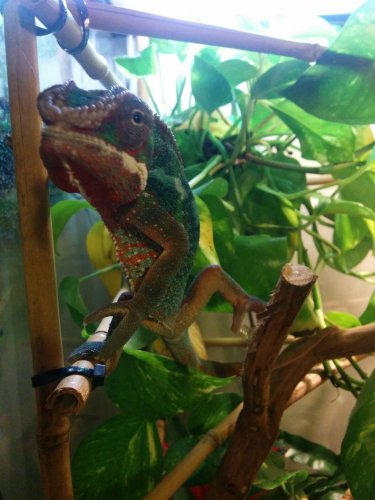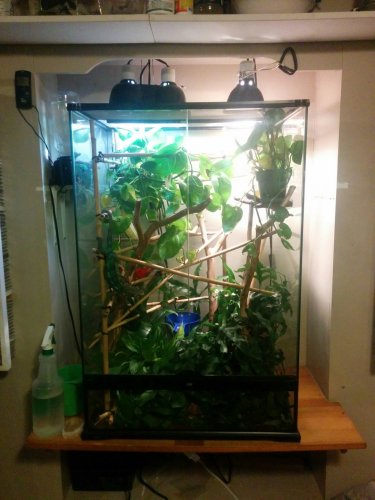Yoshi13
Member
My fiancé and I are first time Cham parents. We have had Yoshi for about 6 weeks. One thing we have learned from the research we have done is that preventative care is what matters most for Chameleons. We have taken the time to include as much detail about our set up as possible and would love to get some feedback from this great community about anything we are doing right, and of course what we could be doing better!!!
Chameleon Info:
o Your Chameleon - The species, sex, and age of your chameleon. How long has it been in your care?
o Ambilobe Panther, 9 months old and has been in our care for 1.5 months
o Handling - How often do you handle your chameleon?
o About 1x per day we take him out and let him hang out on either us or a large fern with a bamboo trellis
o Feeding - What are you feeding your cham? What amount? What is the schedule? How are you gut-loading your feeders?
o He is a picky guy. We are feeding him crickets, superworms and butterworms. Other than feeders he seems to like a little banana. I switch it up but so far am gutloading the feeders with spinach, broccoli, apple, carrot, and we use cricket water that is supplemented with calcium (the Fluker’s Cricket Quencher)
o In terms of how much we feed him, usually we leave a few crickets in the enclosure (he has been ignoring them lately) and usually a couple worms per day (either superworms or butterworms). We have been feeding hornworms every few weeks. I know that the worms are not ideal but it’s almost he eats at the moment and we try to gutload them well. Any tips on other good feeders that people have had success with would be great. We were wondering if maybe he just gets bored quick as he was all about the crickets for about a week now doesn't seem to care too much.
o Supplements - What brand and type of calcium and vitamin products are you dusting your feeders with and what is the schedule?
o We are using Fluker’s Calcium w/D3 and Fluker’s Liquid Calcium supplement as well as Reptivite. We add the liquid calcium to his dripper and use a drop daily on our feeders
o Watering - What kind of watering technique do you use? How often and how long to you mist? Do you see your chameleon drinking?
o We do a long warm mist in the morning for at least 5 minutes and run a dripper with liquid calcium in it during the day. At night when I get home (around 5) I do another warm shower for about 5 minutes (and we spray HIM directly not just the plants)
o I’m concerned as I never really see him drink. He licks a bit but nothing special. He used the dripper at first but unless he is using it during the day while I’m not home I don’t think he is interested in it.
o Fecal Description - Briefly note colors and consistency from recent droppings. Has this chameleon ever been tested for parasites?
o He has never been tested for parasites but we know he was captive bred and born. He usually goes about 1x per week. Sometimes there is a little bit of an orange tinge to the urate but I have read if he isn’t having movements all the time that could explain it. I also ready that feeding worms can do this. My concern is I know orange represents possible dehydration so I wasn’t sureabout that?
o History - Any previous information about your cham that might be useful to others when trying to help you.
o Nothing in particular
Cage Info:
o Cage Type - Describe your cage (Glass, Screen, Combo?) What are the dimensions?
o We have an Exo Terra Medium Tall (vented in the front, full mesh top) it is 60 x 45 x 60 cm / 24” x 18” x 24” (WxDxH)
o Lighting - What brand, model, and types of lighting are you using? What is your daily lighting schedule?
o Lights on at 7am, lights out at 9pm
o We use a 26w UVB (Exo Terra), 13w Reptivision (Exoterra) and a 75w intense basking light (Exo)
o Temperature - What temp range have you created (cage floor to basking spot)? Lowest overnight temp? How do you measure these temps?
o Basking is 90 degrees, cage temp is between 70-75 degrees
o We measure the temps with a thermometer by the basking spot at the top of the cage (90 degrees) and another barometer/thermometer on the top, back left side of the cage to measure ambient temps. I haven’t been measuring the floor but that is where we run an exo heating cable to keep the cage warm enough
o Humidity - What are your humidity levels? How are you creating and maintaining these levels? What do you use to measure humidity?
o Drops down to around 25% during the day between sprays, up normally to 70% when we do our misting/showers
o Plants - Are you using live plants? If so, what kind?
o All live plants. Pothos and Bromeliad.
o Placement - Where is your cage located? Is it near any fans, air vents, or high traffic areas? At what height is the top of the cage relative to your room floor?
o 2 feet off the floor. Not near any fans or high traffic areas. The top of the cage is probably 6 inches from the ceiling.
o Location - Where are you geographically located?
o Burlington, Ontario, Canada
Current Problem - At present we are concerned about everything!!! We just want feedback and input to make sure we are doing things right. We have learned a lot from this forum over the past few months and are always seeking to improve life for our little guy
Thanks in advance for comments and feedback!
Chameleon Info:
o Your Chameleon - The species, sex, and age of your chameleon. How long has it been in your care?
o Ambilobe Panther, 9 months old and has been in our care for 1.5 months
o Handling - How often do you handle your chameleon?
o About 1x per day we take him out and let him hang out on either us or a large fern with a bamboo trellis
o Feeding - What are you feeding your cham? What amount? What is the schedule? How are you gut-loading your feeders?
o He is a picky guy. We are feeding him crickets, superworms and butterworms. Other than feeders he seems to like a little banana. I switch it up but so far am gutloading the feeders with spinach, broccoli, apple, carrot, and we use cricket water that is supplemented with calcium (the Fluker’s Cricket Quencher)
o In terms of how much we feed him, usually we leave a few crickets in the enclosure (he has been ignoring them lately) and usually a couple worms per day (either superworms or butterworms). We have been feeding hornworms every few weeks. I know that the worms are not ideal but it’s almost he eats at the moment and we try to gutload them well. Any tips on other good feeders that people have had success with would be great. We were wondering if maybe he just gets bored quick as he was all about the crickets for about a week now doesn't seem to care too much.
o Supplements - What brand and type of calcium and vitamin products are you dusting your feeders with and what is the schedule?
o We are using Fluker’s Calcium w/D3 and Fluker’s Liquid Calcium supplement as well as Reptivite. We add the liquid calcium to his dripper and use a drop daily on our feeders
o Watering - What kind of watering technique do you use? How often and how long to you mist? Do you see your chameleon drinking?
o We do a long warm mist in the morning for at least 5 minutes and run a dripper with liquid calcium in it during the day. At night when I get home (around 5) I do another warm shower for about 5 minutes (and we spray HIM directly not just the plants)
o I’m concerned as I never really see him drink. He licks a bit but nothing special. He used the dripper at first but unless he is using it during the day while I’m not home I don’t think he is interested in it.
o Fecal Description - Briefly note colors and consistency from recent droppings. Has this chameleon ever been tested for parasites?
o He has never been tested for parasites but we know he was captive bred and born. He usually goes about 1x per week. Sometimes there is a little bit of an orange tinge to the urate but I have read if he isn’t having movements all the time that could explain it. I also ready that feeding worms can do this. My concern is I know orange represents possible dehydration so I wasn’t sureabout that?
o History - Any previous information about your cham that might be useful to others when trying to help you.
o Nothing in particular
Cage Info:
o Cage Type - Describe your cage (Glass, Screen, Combo?) What are the dimensions?
o We have an Exo Terra Medium Tall (vented in the front, full mesh top) it is 60 x 45 x 60 cm / 24” x 18” x 24” (WxDxH)
o Lighting - What brand, model, and types of lighting are you using? What is your daily lighting schedule?
o Lights on at 7am, lights out at 9pm
o We use a 26w UVB (Exo Terra), 13w Reptivision (Exoterra) and a 75w intense basking light (Exo)
o Temperature - What temp range have you created (cage floor to basking spot)? Lowest overnight temp? How do you measure these temps?
o Basking is 90 degrees, cage temp is between 70-75 degrees
o We measure the temps with a thermometer by the basking spot at the top of the cage (90 degrees) and another barometer/thermometer on the top, back left side of the cage to measure ambient temps. I haven’t been measuring the floor but that is where we run an exo heating cable to keep the cage warm enough
o Humidity - What are your humidity levels? How are you creating and maintaining these levels? What do you use to measure humidity?
o Drops down to around 25% during the day between sprays, up normally to 70% when we do our misting/showers
o Plants - Are you using live plants? If so, what kind?
o All live plants. Pothos and Bromeliad.
o Placement - Where is your cage located? Is it near any fans, air vents, or high traffic areas? At what height is the top of the cage relative to your room floor?
o 2 feet off the floor. Not near any fans or high traffic areas. The top of the cage is probably 6 inches from the ceiling.
o Location - Where are you geographically located?
o Burlington, Ontario, Canada
Current Problem - At present we are concerned about everything!!! We just want feedback and input to make sure we are doing things right. We have learned a lot from this forum over the past few months and are always seeking to improve life for our little guy
Thanks in advance for comments and feedback!



